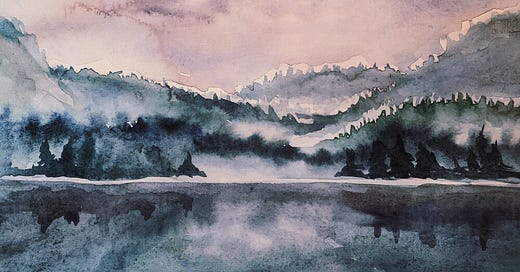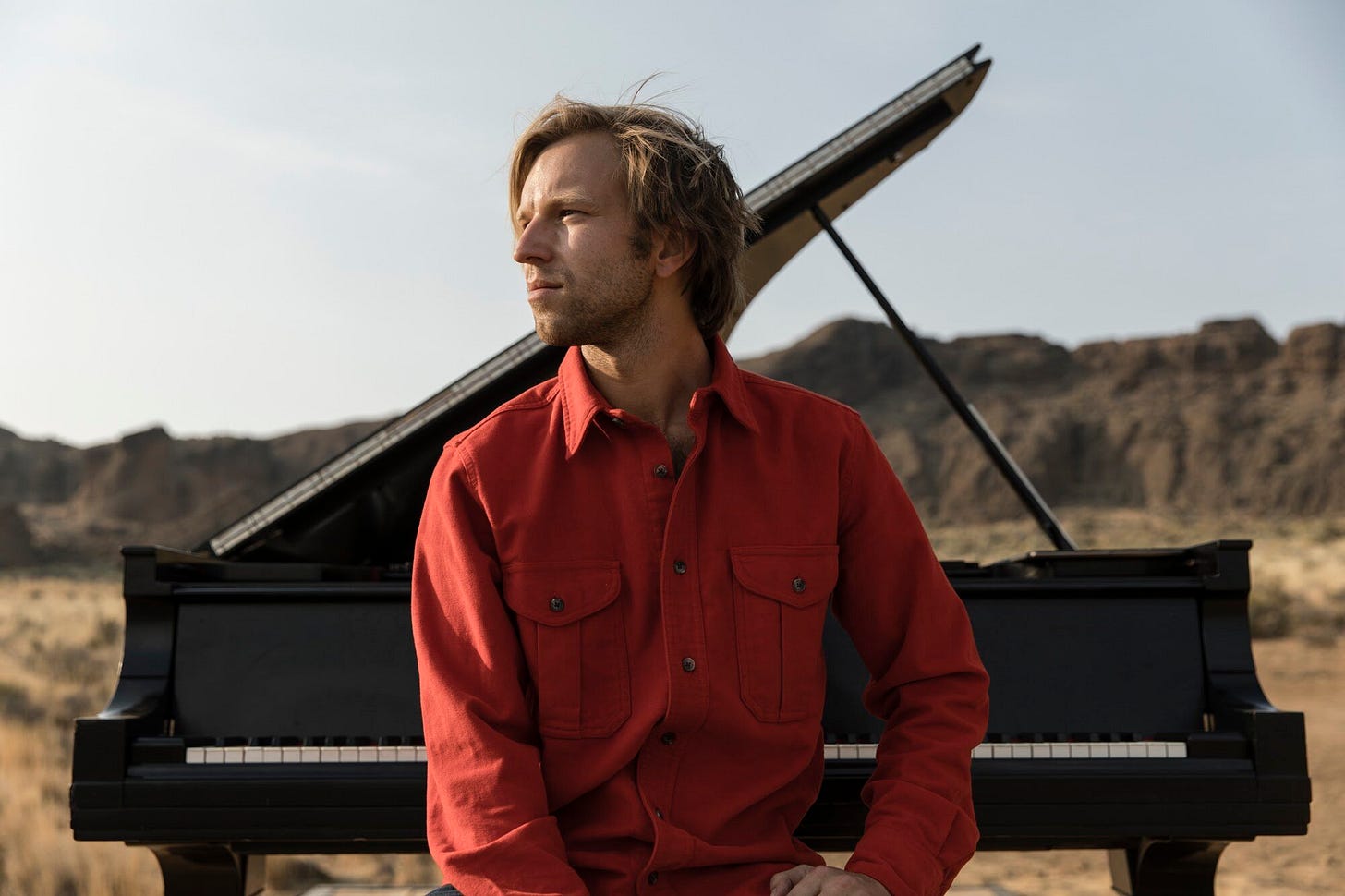[from the archives] the blue of distance
from February 2021. on longing, distance, landscape, and the color blue. feat. Rebecca Solnit, Maggie Nelson, and Joan Didion
Study in Blue, by me. Instead of featuring one visual artist this month, I’m sharing with you how the color blue has appeared in my vicinity, periphery, and interior landscapes.
hello friend,
In Swedish, there’s a beautiful saying to express the sentiment “I miss you”—jag längtar efter dig (“I am longing for you”).
Longing is a curious emotion—desire tinged with distance, the distance between you and I, between here and there, between the versions of our selves we have been and have yet to be.
In Within, we’ve been discussing the cylical/circular nature of growth, healing, and unfolding (as opposed to its linearity). This winter, with much of the usual noise drowned out, I find myself returning to the same things I tend to encounter when I get quiet enough to listen: namely a super-saturated longing and nostalgia.
In the quiet corners of this month I’ve been comforted by the words of Rebecca Solnit in A Field Guide to Getting Lost, a salve for this time of great distance hanging between us and the humans/places/things we love. Solnit’s blue of distance gave me a language for an emotion I haven’t been able to articulate:
“We treat desire as a problem to be solved, address what desire is for and focus on that something and how to acquire it rather than on the nature and sensation of desire, though often it is the distance between us and the object of desire that fills the space in between with the blue of longing.”
I wonder sometimes whether with a slight adjustment adjustment of perspective it could be cherished as a sensation on its own terms, since it is as inherent to the human condition as blue is to distance?
If you can look across the distance without wanting to close it up, if you can own your longing in the same way that you own the beauty of that blue that can never be possessed?
For something of this longing will, like the blue of distance, only be relocated, not assuaged, by acquisition and arrival, just as the mountains cease to be blue when you arrive among them and the blue instead tints the next beyond.” (Solnit 2005: 30)
This concept of owning one’s longing, cherishing it as a sensation in its own right, rather than rushing to fix or close it, knowing we will only ever locate it elsewhere, is exactly what I feel like I’m sitting with this year, these months, where the distance and longing (particularly for family and home) seem to only crescendo. I wonder how this lands with you, in your blue distance, in your longing.
Solnit’s words also attuned me to how blue and longing were showing up around and within me, and how other literary greats associate the color blue with complex human emotions. This led me first to Maggie Nelson’s Bluets, a tribute to the color blue which reads more like a poem-list-incantation-meditation (“Loneliness is solitude with a problem. Can blue solve the problem, or can it at least keep me company within it?—No, not exactly. It cannot love me that way; it has no arms”). Then to Joan Didion’s Blue Nights (“Blue nights are the opposite of the dying of the brightness, but they are also its warning.”). And to Joni Mitchell’s Blue (“Hey Blue, here is a song for you / Ink on a pin / Underneath the skin / An empty place to fill in”)
Vol. 02, Issue 02 of T H E | L I M I N A L is a meditation on longing, landscape, sound, listening, refracted through the color blue. I also have an absolute treat for you this month. We’re kicking off the PORTRAITS interview series with one of my favorite artists and also a dear friend, the exceptionally talented and creative concert pianist Hunter Noack. His In A Landscape brings classical music to some of the least likely places. Scroll down to read more.
Thank you for being here. Let’s dive into the deep blue.
xx, A
My Blue Distance, photograph taken back home in Oregon looking West toward the Cascades Mountains, summer 2019. “We love to contemplate blue,” wrote Goethe “not because it advances to us, but because it draws us after it.”
VOICE
“The world is blue at its edges and in its depths. This blue is the light that got lost. Light at the blue end of the spectrum does not travel the whole distance from the sun to us. It disperses among the molecules of the air, it scatters in water…
This light that does not touch us, does not travel the whole distance, the light that gets lost, gives us the beauty of the world, so much of which is in the color blue.
For many years, I have been moved by the blue at the far edge of what can be seen, that color of horizons, of remote mountain ranges, of anything far away. The color of that distance is the color of an emotion, the color of solitude and of desire, the color of there seen from here, the color of where you are not. And the color of where you can never go.
For the blue is not in the place those miles away at the horizon, but in the atmospheric distance between you and the mountains. ‘Longing,’ says the poet Robert Hass, ‘because desire is full of endless distances.’ Blue is the color of longing for the distances you never arrive in, for the blue world.”
— Rebecca Solnit, A Field Guide to Getting Lost
Yves Klein's [1928-1962] “Relief Planétaire (RP 9)”, or, How to Get Pantone to Name a Color After You. Rebecca Solnit writes about Klein’s iconic blue relief maps: “Painting the world blue made it all terra incognita, indivisible and unconquerable, a ferocious act of mysticism.”
PORTRAITS
I can’t think of a better way to kick off this new series—nor to bring these musings on geography, distance, and landscape to life—than with my dear friend, Hunter Noack. Hunter and I grew up together for a time in Oregon before his music career took him to study and perform in Interlochen, LA, and London, among many other places. He has since returned to Oregon to share his music in the most unlikely way.
Click below to join our conversation about classical music, public lands, the possibilities for art and the importance of access in today’s world, landscape, liminality, and more.
Hunter Noack :: Classical Piano in the Wild
The words “concert piano” typically conjure up the image of a grand concert hall, perhaps an accompanying orchestra, pressed white-collared shirts and coattails… but most certainly not a flatbed truck
EXCERPTS:
"As a white male and son of a country built on the genocide of indigenous nations, I am aware of my privilege, waltzing around the country towing a grand piano — a classic symbol of western art and culture. But set among the trees, accompanying my friend and colleague James Edmund Greeley, a Native American flutist, this symbol of oppression holds new meaning. It is a symbol of listening, of cooperation, friendship, and new solutions to old problems.”
“I feel that I am —very slowly— becoming more myself by being regularly gobsmacked by the beauty and stillness and magnitude of the land under the restless sky…
…From my living room, looking East to watch the sunrise or the light of the sunset, I see no sign of human life. No roads, no lights, no houses, no cattle until the ridge meets the horizon 40 miles away. This has been my liminal space.”
Cyanometer by Horace-Bénédict de Saussure, ca. 1760
SPILLED WORDS
writing in-process, in-formation. fragments, not wholes. notes to self over the past month on how and where blue has appeared to me.
blue notes
23. My father, having just recently undergone cataract surgery, remarks how blue now appears “more purple.” When I ask him if he expects it to “go back to normal,” he indicates that this more-purple-blue is the normal. All along, he says, film coating his lenses was tinting his blue towards a golden/sepia spectrum. I can’t help but think of how photographs do the same with time. Can a color become more or less true? Are time and age a filter or a lens, or both? What do they make visible? Obscure?
7. The fog I wrote you about last month is still there, lingering, heavier most days, though I’m trying to spend less energy scrutinizing its shapes. I revisit the words I wrote you, and laugh silently to myself reading the last line—that for a moment, absent of fog, ”the sky was so damn blue”—as if the fog could not also be it too. It hangs in thick blue conversation with the sea, and sometimes, in the early hours of the day, I get to listen in.
19. Tobias and I cycle again and again back to the question of whether a Good Life exists in the city or the countryside, as if it were somewhere out there, when really I wonder if the question we’re actually asking is how many shades of blue do we see, how much horizon is there to long for?
4. February is a blue month, in the ways that late winter holds a monopoly on the color, in the ways that nostalgia and longing return to me and I to them, like loud ghosts who haven’t yet made themselves adequately heard, who have something left to say.
WRITING PROMPTS
What is your relationship to longing? How does it feel in your body? Does it take up residence in a particular place?
Stream-of-consciousness: write about the color Blue and what associations it evokes for you: do not edit or filter; let yourself be surprised.
Inspired by Hunter’s In a Landscape, can you describe the aural (sound) quality of a particular landscape that holds a place in your heart?
RESOURCES
OFFERING:
WITHIN, my series on yoga + embodied writing, has blossomed into two new iterations this spring:
A community / circle of womxn who meet monthly to practice together, learn from one another, and lift each other up at the intersection of embodiment praxis and writing (this is a continuation for those who have already participated in Within: 6 weeks in Seasons 1 / 2).
New for Season 3* (Spring 2021): Within: 6 Weeks On Your Time. I will be offering the 6 weeks — sessions, prompts, rituals, and resources — in an on-demand format for you to practice on your own time. Details coming very soon, please pop your name on the waitlist if interested and you’ll be the first to know.
*The live version of the 6-week journey will return in late summer/early fall 2021.
WATCHING:
Have you been having zany, stranger-than-fiction dreams during the pandemic? You are not alone. Friend, filmmaker, and Liminal community member Megan McDonough’s documentary short “Invisible Monsters and Tomato Soup”, recently published in The New Yorker, “considers the shape that the coronavirus makes in the dreaming mind.”
DOING:
Friend, choreographer, dancer, and Liminal community member Joseph Lau’s “An Absurdist Archive of Isolation: A Full Body Workout Radio Play” defies genre, but is above all things embodied and interactive. I had the privilege of brainstorming a bit with Joe when the project was in its early stages and cannot wait to
READING:
This essay—Surviving Your Thirties: AKA the Panic Years—on motherhood, identity, aging, and biological clocks speaks to so much that has been coursing through my brain and heart the past few months.
LISTENING:
Life, Reimagined — a conversation with writer Suleika Jaouad on her debut memoir, Between Two Kingdoms
GIVING:
Mutual Aid for Texas’ climate crisis
PLAYLIST OF THE MONTH









